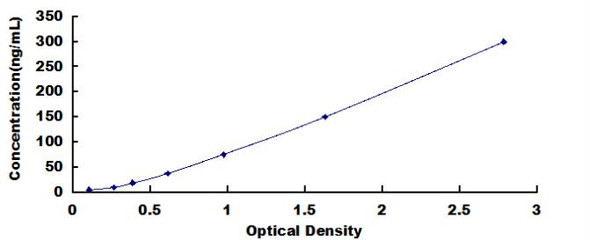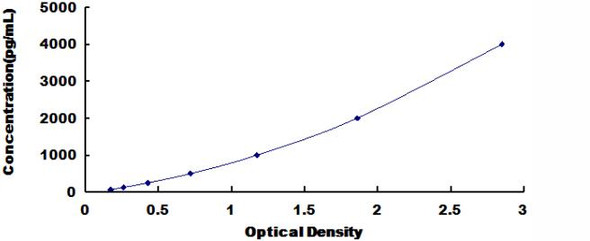Description
Human Insulin-like growth factor-binding protein 3 (IGFBP3) ELISA Kit
The Human Insulin-Like Growth Factor Binding Protein 3 (IGFBP3) ELISA Kit is a powerful tool for quantifying the levels of IGFBP3 in human samples including serum, plasma, and cell culture supernatants. This kit is designed with precision and accuracy in mind, offering high sensitivity and specificity for reliable and reproducible results, making it suitable for a variety of research applications.IGFBP3 is a key player in regulating insulin-like growth factor (IGF) signaling pathways, influencing cell growth, differentiation, and survival.
Dysregulation of IGFBP3 has been implicated in various diseases such as cancer, diabetes, and osteoporosis, making it a valuable biomarker for understanding disease pathogenesis and exploring potential therapeutic interventions.By using the Human IGFBP3 ELISA Kit, researchers can gain valuable insights into the role of IGFBP3 in health and disease, paving the way for innovative research and clinical advancements in the field of molecular biology and medicine.
| Product Name: | Human Insulin-like growth factor-binding protein 3 (IGFBP3) ELISA Kit |
| SKU: | HUEB0015 |
| Size: | 96T |
| Target: | Human Insulin-like growth factor-binding protein 3 (IGFBP3) |
| Synonyms: | IBP-3, IBP3 |
| Assay Type: | Sandwich |
| Detection Method: | ELISA |
| Reactivity: | Human |
| Detection Range: | 125-8000pg/mL |
| Sensitivity: | 50pg/mL |
| Intra CV: | 4.5% | ||||||||||||||||||||
| Inter CV: | 7.5% | ||||||||||||||||||||
| Linearity: |
| ||||||||||||||||||||
| Recovery: |
| ||||||||||||||||||||
| Function: | IGF-binding proteins prolong the half-life of the IGFs and have been shown to either inhibit or stimulate the growth promoting effects of the IGFs on cell culture. They alter the interaction of IGFs with their cell surface receptors. Also exhibits IGF-independent antiproliferative and apoptotic effects mediated by its receptor TMEM219/IGFBP-3R. |
| Uniprot: | P17936 |
| Sample Type: | Serum, plasma, tissue homogenates, cell culture supernates and other biological fluids |
| Specificity: | Natural and recombinant human Insulin-like growth factor-binding protein 3 |
| Sub Unit: | Interacts with XLKD1 (By similarity). Binds IGF2 more than IGF1. Forms a ternary complex of about 140 to 150 kDa with IGF1 or IGF2 and a 85 kDa glycoprotein (ALS). Interacts with HN. Interacts with TMEM219. |
| Research Area: | Cancer |
| Subcellular Location: | Secreted |
| Storage: | Please see kit components below for exact storage details |
| Note: | For research use only |
| UniProt Protein Function: | IGFBP3: IGF-binding proteins prolong the half-life of the IGFs and have been shown to either inhibit or stimulate the growth promoting effects of the IGFs on cell culture. They alter the interaction of IGFs with their cell surface receptors. Also exhibits IGF-independent antiproliferative and apoptotic effects mediated by its receptor TMEM219/IGFBP-3R. |
| UniProt Protein Details: | Protein type:Secreted; Cell development/differentiation; Secreted, signal peptide Chromosomal Location of Human Ortholog: 7p12.3 Cellular Component: extracellular region; extracellular space; insulin-like growth factor binding protein complex; nucleus Molecular Function:fibronectin binding; insulin-like growth factor binding; insulin-like growth factor I binding; insulin-like growth factor II binding; metal ion binding; protein binding; protein tyrosine phosphatase activator activity Biological Process: apoptosis; cellular protein metabolic process; negative regulation of cell proliferation; negative regulation of protein amino acid phosphorylation; negative regulation of signal transduction; negative regulation of smooth muscle cell migration; negative regulation of smooth muscle cell proliferation; osteoblast differentiation; positive regulation of apoptosis; positive regulation of catalytic activity; positive regulation of insulin-like growth factor receptor signaling pathway; positive regulation of MAPKKK cascade; positive regulation of myoblast differentiation; protein amino acid phosphorylation; regulation of cell growth; regulation of insulin-like growth factor receptor signaling pathway |
| NCBI Summary: | This gene is a member of the insulin-like growth factor binding protein (IGFBP) family and encodes a protein with an IGFBP domain and a thyroglobulin type-I domain. The protein forms a ternary complex with insulin-like growth factor acid-labile subunit (IGFALS) and either insulin-like growth factor (IGF) I or II. In this form, it circulates in the plasma, prolonging the half-life of IGFs and altering their interaction with cell surface receptors. Alternate transcriptional splice variants, encoding different isoforms, have been characterized. [provided by RefSeq, Jul 2008] |
| UniProt Code: | P17936 |
| NCBI GenInfo Identifier: | 146327827 |
| NCBI Gene ID: | 3486 |
| NCBI Accession: | P17936.2 |
| UniProt Secondary Accession: | P17936,Q2V509, Q6P1M6, Q9UCL4, A4D2F5, D3DVM0, |
| UniProt Related Accession: | P17936 |
| Molecular Weight: | 32,223 Da |
| NCBI Full Name: | Insulin-like growth factor-binding protein 3 |
| NCBI Synonym Full Names: | insulin like growth factor binding protein 3 |
| NCBI Official Symbol: | IGFBP3 |
| NCBI Official Synonym Symbols: | IBP3; BP-53 |
| NCBI Protein Information: | insulin-like growth factor-binding protein 3 |
| UniProt Protein Name: | Insulin-like growth factor-binding protein 3 |
| Protein Family: | Insulin-like growth factor-binding protein |
| UniProt Gene Name: | IGFBP3 |
| UniProt Entry Name: | IBP3_HUMAN |
| Component | Quantity (96 Assays) | Storage |
| ELISA Microplate (Dismountable) | 8×12 strips | -20°C |
| Lyophilized Standard | 2 | -20°C |
| Sample Diluent | 20ml | -20°C |
| Assay Diluent A | 10mL | -20°C |
| Assay Diluent B | 10mL | -20°C |
| Detection Reagent A | 120µL | -20°C |
| Detection Reagent B | 120µL | -20°C |
| Wash Buffer | 30mL | 4°C |
| Substrate | 10mL | 4°C |
| Stop Solution | 10mL | 4°C |
| Plate Sealer | 5 | - |
Other materials and equipment required:
- Microplate reader with 450 nm wavelength filter
- Multichannel Pipette, Pipette, microcentrifuge tubes and disposable pipette tips
- Incubator
- Deionized or distilled water
- Absorbent paper
- Buffer resevoir
*Note: The below protocol is a sample protocol. Protocols are specific to each batch/lot. For the correct instructions please follow the protocol included in your kit.
Allow all reagents to reach room temperature (Please do not dissolve the reagents at 37°C directly). All the reagents should be mixed thoroughly by gently swirling before pipetting. Avoid foaming. Keep appropriate numbers of strips for 1 experiment and remove extra strips from microtiter plate. Removed strips should be resealed and stored at -20°C until the kits expiry date. Prepare all reagents, working standards and samples as directed in the previous sections. Please predict the concentration before assaying. If values for these are not within the range of the standard curve, users must determine the optimal sample dilutions for their experiments. We recommend running all samples in duplicate.
| Step | |
| 1. | Add Sample: Add 100µL of Standard, Blank, or Sample per well. The blank well is added with Sample diluent. Solutions are added to the bottom of micro ELISA plate well, avoid inside wall touching and foaming as possible. Mix it gently. Cover the plate with sealer we provided. Incubate for 120 minutes at 37°C. |
| 2. | Remove the liquid from each well, don't wash. Add 100µL of Detection Reagent A working solution to each well. Cover with the Plate sealer. Gently tap the plate to ensure thorough mixing. Incubate for 1 hour at 37°C. Note: if Detection Reagent A appears cloudy warm to room temperature until solution is uniform. |
| 3. | Aspirate each well and wash, repeating the process three times. Wash by filling each well with Wash Buffer (approximately 400µL) (a squirt bottle, multi-channel pipette,manifold dispenser or automated washer are needed). Complete removal of liquid at each step is essential. After the last wash, completely remove remaining Wash Buffer by aspirating or decanting. Invert the plate and pat it against thick clean absorbent paper. |
| 4. | Add 100µL of Detection Reagent B working solution to each well. Cover with the Plate sealer. Incubate for 60 minutes at 37°C. |
| 5. | Repeat the wash process for five times as conducted in step 3. |
| 6. | Add 90µL of Substrate Solution to each well. Cover with a new Plate sealer and incubate for 10-20 minutes at 37°C. Protect the plate from light. The reaction time can be shortened or extended according to the actual color change, but this should not exceed more than 30 minutes. When apparent gradient appears in standard wells, user should terminatethe reaction. |
| 7. | Add 50µL of Stop Solution to each well. If color change does not appear uniform, gently tap the plate to ensure thorough mixing. |
| 8. | Determine the optical density (OD value) of each well at once, using a micro-plate reader set to 450 nm. User should open the micro-plate reader in advance, preheat the instrument, and set the testing parameters. |
| 9. | After experiment, store all reagents according to the specified storage temperature respectively until their expiry. |
When carrying out an ELISA assay it is important to prepare your samples in order to achieve the best possible results. Below we have a list of procedures for the preparation of samples for different sample types.
| Sample Type | Protocol |
| Serum | If using serum separator tubes, allow samples to clot for 30 minutes at room temperature. Centrifuge for 10 minutes at 1,000x g. Collect the serum fraction and assay promptly or aliquot and store the samples at -80°C. Avoid multiple freeze-thaw cycles. If serum separator tubes are not being used, allow samples to clot overnight at 2-8°C. Centrifuge for 10 minutes at 1,000x g. Remove serum and assay promptly or aliquot and store the samples at -80°C. Avoid multiple freeze-thaw cycles. |
| Plasma | Collect plasma using EDTA or heparin as an anticoagulant. Centrifuge samples at 4°C for 15 mins at 1000 × g within 30 mins of collection. Collect the plasma fraction and assay promptly or aliquot and store the samples at -80°C. Avoid multiple freeze-thaw cycles. Note: Over haemolysed samples are not suitable for use with this kit. |
| Urine & Cerebrospinal Fluid | Collect the urine (mid-stream) in a sterile container, centrifuge for 20 mins at 2000-3000 rpm. Remove supernatant and assay immediately. If any precipitation is detected, repeat the centrifugation step. A similar protocol can be used for cerebrospinal fluid. |
| Cell culture supernatant | Collect the cell culture media by pipette, followed by centrifugation at 4°C for 20 mins at 1500 rpm. Collect the clear supernatant and assay immediately. |
| Cell lysates | Solubilize cells in lysis buffer and allow to sit on ice for 30 minutes. Centrifuge tubes at 14,000 x g for 5 minutes to remove insoluble material. Aliquot the supernatant into a new tube and discard the remaining whole cell extract. Quantify total protein concentration using a total protein assay. Assay immediately or aliquot and store at ≤ -20 °C. |
| Tissue homogenates | The preparation of tissue homogenates will vary depending upon tissue type. Rinse tissue with 1X PBS to remove excess blood & homogenize in 20ml of 1X PBS (including protease inhibitors) and store overnight at ≤ -20°C. Two freeze-thaw cycles are required to break the cell membranes. To further disrupt the cell membranes you can sonicate the samples. Centrifuge homogenates for 5 mins at 5000xg. Remove the supernatant and assay immediately or aliquot and store at -20°C or -80°C. |
| Tissue lysates | Rinse tissue with PBS, cut into 1-2 mm pieces, and homogenize with a tissue homogenizer in PBS. Add an equal volume of RIPA buffer containing protease inhibitors and lyse tissues at room temperature for 30 minutes with gentle agitation. Centrifuge to remove debris. Quantify total protein concentration using a total protein assay. Assay immediately or aliquot and store at ≤ -20 °C. |
| Breast Milk | Collect milk samples and centrifuge at 10,000 x g for 60 min at 4°C. Aliquot the supernatant and assay. For long term use, store samples at -80°C. Minimize freeze/thaw cycles. |









